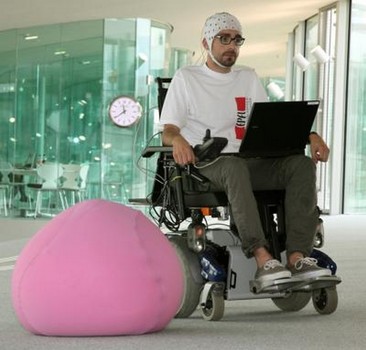Scientists from the Cognitive Neuroscience Society (CNS) are developing neuroprosethetic devices that can decode brain signals, discern the actions the bodies want to take, and use advanced robots to function as a spinal cord. The project was presented as a talk by José del R. Millán at the CNS annual meeting in San Francisco, California. Millán is a researcher at the Swiss Federal Institute of Technology in Lausanne, Switzerland.
Neuroscientists are currently designing new prosthetic devices inspired by natural motor control which they say can replace limb function. For this project, Millán and a team of researchers tested different types of brain-controlled devices from advanced limbs to robots to wheelchairs that help their users to perform complex tasks.
Millán began his work by designing autonomous robots that could learn from their experiences. He became interested in developing robots that could help disabled people in what he says is a “very natural, direct and intuitive way” by instructing robots to decode the users’ intentions from their brain signals. The brain-computer interfaces (BCIs) could help users to restore functions such as hand grasping and locomotion or provide mobility to people in wheelchairs.
“The prostheses and robots that our BCIs control are intelligent, as they can interpret many low-level details that are not necessarily coded in the mental commands,” Millán said. This function works in a way similar to how deep brain areas, the musculoskeletal system and the spinal cord, allowing bodies to do simple tasks while the users’ attention is focussed elsewhere.
Various brain-controlled devices were tested on people with motor disabilities, which were severe in some cases. The participants were able to do both voluntary and spontaneous tasks such as writing and navigation at levels that were similar to healthy control groups. The users modulated electrical brain activity, known as EEGs, to deliver commands. The EEGs are recorded by non-invasive probes on the scalp. “It also provides a global picture of our brain patterns, what is necessary to decode all the variety of neural correlates we want to exploit,” Millán said.
The participants were trained for no more than 9 sessions to operate the devices. The BCIs mainly processes the users’ intentions and decision-making mainly from the cerebral cortex, but many parts of skilled movements are also handled in the brainstem and spinal cord.
“By designing the intelligent device to control the lower-level movements in concert with the higher-level brain activity from the BCI, the neuroprostheses come closer to natural motor control. “We aim to interact with these neuroprostheses as if they were our new body, using the very same neural signals and principles that control our muscles,” Millán says.
“Future neuroprostheses — robots and exoskeletons controlled via a BCI – will be tightly coupled with the user in such a way that the resulting system can replace and restore impaired limb functions because it will be controlled by the same neural signals as their natural counterparts,” Millán says. “This is no longer science fiction. The questions now are which are the key components to guarantee reliability and long-term operation of neuroprostheses, and when they will be part of the clinical portfolio available to motor-disabled people.”















